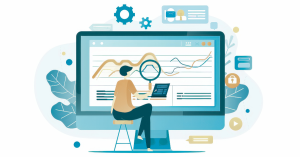In a perfect world, every visit and subsequent click on your website landing pages, email campaigns, and social media posts would come from a living, breathing human being who wants to engage with your business and potentially buy your products or services. Sadly, not all traffic is created equal.
According to Statista, 50% of all traffic on the internet comes from bots. To confuse the situation further, some bot traffic is good (even necessary), and some bot traffic is downright dangerous. This creates big problems for marketers.
In this post, we’ll explain what bot traffic is, the risks it presents, and how the emfluence Marketing Platform can remove bot traffic from your marketing reports.
What is Bot Traffic?
Essentially, bot traffic refers to non-human visits to a website generated by an automated computer script or bot. Some bot traffic is welcome and actively encouraged. Good bots include essential web crawlers from major search engines that help rank our websites against specific keywords and phrases and help our websites become more discoverable. However, some bots can be harmful and contribute to ad fraud, data scraping, and cyber attacks.
How to Identify Bot Traffic
The following red flags are a surefire sign that you have a problem with bot traffic:
- High Bounce Rates: Bots will typically load a page and leave immediately.
- Unusual Traffic Spikes: Sudden, unexplained surges in visits from specific or unexpected locations.
- Strange User Behavior: This might include extremely short session durations or high pageviews per second.
- Unusual Referral Sources: Traffic coming from unknown or shady-looking websites.
Why Should Marketers Worry About Bot Traffic?
There are many reasons why marketers should be concerned about bot traffic. These include:
1. Skewed Analytics
Bots can inflate website traffic, making it difficult to measure real user engagement. This can lead to marketers misinterpreting campaign performance and potentially optimizing their strategies based on misleading data.
2. Wasted Ad Spend
Bot-powered click fraud can waste marketing budgets without producing genuine leads or sales. These fraudulent clicks diminish the effectiveness of display advertising campaigns, leading to lower ROI and distorted performance metrics.
3. Conversion Rate Misinterpretation
High bot traffic can artificially lower conversion rates, making your campaigns look ineffective. As a result, marketers might abandon strategies that are actually working due to misleading data.
4. SEO Issues & Search Engine Penalties
While you will want to attract genuine search engine web crawlers, unwanted bot traffic can increase bounce rates and reduce session durations, negatively affecting your search rankings. Malicious bots may scrape and copy your content, leading to duplicate content issues and SEO penalties.
5. Security Risks
Criminal networks deploy bots to facilitate credential stuffing — an attempt to access online accounts using stolen usernames and passwords. Additionally, bots play a key role in sophisticated DDoS attacks, overwhelming websites and causing them to slow down or completely crash, ultimately disrupting customer experiences and costing money.
How to Block Unwanted Bot Traffic
Now that we know what a nuisance bots can be for digital marketers, it’s time to fight back. Here’s how you can block unwanted bot traffic:
1. Deploy a Web Application Firewall (WAF)
Think of a WAF as your website’s security checkpoint. Services like Cloudflare, AWS Shield, and Akamai analyze real-time traffic, blocking harmful bots before they reach your site. A WAF ensures that only legitimate visitors get through by filtering out bad actors based on IP reputation, behavior, and known bot signatures.
2. Put Bot Detection Tools to Work
If bots are slipping past your defenses, Google reCAPTCHA, hCaptcha, and Turnstile can help. These tools force visitors to prove they’re human before they can submit forms, create accounts, or log in, stopping automated scripts in their tracks.
3. Keep an Eye on Traffic & Block Suspicious IPs
Your analytics can reveal a lot about bot activity. Look out for unusual traffic spikes, high bounce rates, or excessive hits from the same IPs or regions. Once you spot the patterns, you can block known bad IP addresses at the server level or through your firewall to reduce unwanted visitors.
4. Set Limits to Stop Bots in Their Tracks
Rate limiting is a simple but effective defense against bots that flood your site with excessive requests. You can prevent bots from overwhelming your system by restricting how many times a single IP can access your pages, submit forms, or attempt logins within a given time frame.
5. Use Robots.txt — But Don’t Rely On It
A robots.txt file tells search engines which parts of your site they can crawl, but here’s the catch: bad bots don’t follow the rules. While it can guide legitimate crawlers, it won’t stop malicious bots from accessing your content. Use it wisely, but don’t treat it as a security solution.
6. Clean Up Your Analytics for More Accurate Reporting
Bot traffic doesn’t just clutter your site; it pollutes your analytics. Marketing automation platforms like emfluence can automatically filter out bot interactions, ensuring your contact scoring and reporting reflect real user engagement (see below).
Removing Bot Traffic from Your Analytics
The emfluence Marketing Platform continues to roll out powerful enhancements designed to filter out bot-driven interactions, giving you a clearer and more accurate picture of your audience’s behavior. There will always be some bot traffic, but these updates help ensure that your email marketing and website tracking data reflect real user activity, leading to better insights and more intelligent marketing decisions.
Smarter Website Tracking
In its recent updates, the emfluence Marketing Platform now automatically detects and excludes known bot traffic (bots must be known in order for emfluence to exclude them from reporting—emfluence regularly reviews and identifies new bots) from website tracking data. This means fewer misleading spikes in engagement caused by automated scripts. Additionally, refinements to how session end times are recorded have eliminated “zero-second” visits, replacing them with a more accurate ‘NA’ marker to improve data clarity.
Fine-Tuning Contact Scores
A Contact Score is a numerical value assigned to contacts based on their engagement with your marketing efforts. It helps marketers measure and prioritize leads, customers, or subscribers based on their interactions with emails, website visits, form submissions, and other tracked activities. If bot traffic has inflated your contact scoring, the emfluence Marketing Platform now gives you control. Marketers can manually adjust contact scores, deducting points from those impacted by bot-driven activity while rewarding genuine engagement from other sources. This ensures that your scoring models remain reliable and actionable. emfluence clients may also choose to remove domains known to have bot-traffic from their email reporting altogether.
What’s Next? Smarter Bot Detection for Landing Pages & Surveys
emfluence is working on extending bot detection to landing pages and surveys, meaning any bot-driven visits or interactions will no longer impact your contact scoring models. As these enhancements roll out, marketers can look forward to even greater accuracy in their analytics and campaign performance metrics.
Learn More
As the threats of bot traffic become evermore persistent, so should your defenses. You need to stay proactive and vigilant and keep your site focused on real customers, not automated traffic. To learn more about how the emfluence Marketing Platform can help you achieve these goals, schedule a demo or sign up for a free 14-day trial of our platform today.


